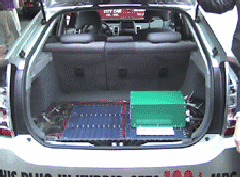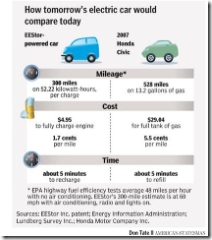 Last week General Motors (GM) gave a boost to plug-in hybrid vehicles. It announced a new gas-saving technology that could transform transportation and make renewable sources of electricity, such as wind and sun, more feasible.
Last week General Motors (GM) gave a boost to plug-in hybrid vehicles. It announced a new gas-saving technology that could transform transportation and make renewable sources of electricity, such as wind and sun, more feasible.
At the Greater Los Angeles Auto Show, the automaker committed to manufacturing versions of its hybrid Saturn Vue SUV with a much larger battery pack that can be charged via an ordinary household socket. The increased size of the battery pack makes it possible to rely more on electric drive than current hybrid vehicles do, thereby saving much more gasoline. The actual rollout date will depend on the development of suitable battery technology, according to GM chairman and CEO Rick Wagoner.
With the announcement, GM joined other major automakers that are developing plug-in hybrid technology, including Ford, Daimler Chrysler, and Toyota. "We hope to have some products in the near future, but we're not prepared to say yet when that will be," says Bruce Brownlee, the senior executive administrator at Toyota Technical Center, in Gardena, CA. "The potential [of plug-in hybrids] is terrific." (None of these car companies have yet committed to widespread production of such a vehicle.)
The announcement marks a change in strategy for GM, which has previously focused on addressing environmental issues and high fuel prices by modifying existing vehicles to run on ethanol and by developing hydrogen fuel-cell vehicles. Although GM still plans to continue its fuel-cell program, the decision to produce plug-in hybrids represents a move toward a more evolutionary transition from internal combustion vehicles. "It's nice to see General Motors not just putting all their bets on hydrogen," says Jason Mark, vehicles director for the Union of Concerned Scientists, based in Cambridge, MA.
Plug-in hybrids, which use both an electric motor and a gasoline-powered internal combustion engine, have been hailed as a bridge technology that could make it possible to cut gasoline consumption in the short term; meanwhile, researchers will continue to work out the problems with all-electric vehicles, such as the high costs that make long-range battery-powered vehicles unaffordable. The most commonly described version of this technology would allow drivers to commute about 20 miles without using gasoline at all. But in reality, plug-in hybrids will likely use a blended strategy, relying on the gasoline engine to boost power for acceleration or for climbing hills even during the first 20 miles. This blended strategy would still mean that a typical commute would use almost no gasoline. "Having an internal combustion engine for passing or hill climbing is probably a prudent thing to do," says Thomas Keim, a principal research engineer at MIT. "But if you're traveling around town or just cruising on the highway, you can do both of those things from the battery."
Plug-in hybrids have an advantage over all-electric vehicles in that the battery would be the primary source of power only for relatively short distances, allowing for a much smaller and less expensive battery pack. Since short trips represent the majority of driving in the Unites States, the result would be a dramatic decrease in gasoline use. Electricity use would go up, but the price of powering a vehicle with electricity from the grid during off-peak hours would be the equivalent of gas for about 90 cents per gallon, says Terry Penney, a technology manager for advanced vehicle technologies at the National Renewable Energy Laboratory, in Golden, CO.
For longer trips, the vehicle would switch to a standard hybrid mode once the battery has been depleted to a certain point, saving fuel the same way today's hybrids do. This includes using energy recaptured from braking, turning off the engine when the vehicle stops, and allowing the gasoline engine to run at a more constant and efficient speed. Incorporating existing technologies--such as six-speed rather than four-speed automatic transmissions, and turning off fuel to pistons that aren't needed--could further improve fuel efficiency. Indeed, Mark says these technologies alone, even without hybrid technology, could improve average fuel economy by 10 miles per gallon--enough to replace all the oil we import from the Middle East. Using ethanol rather than gasoline could further decrease gasoline consumption.
These fuel savings would only be the beginning, many experts say. As battery technology improves, and if plug-in hybrids are successful, the high-volume production of batteries could lower their price. This would make it affordable to increase battery-pack size in successive generations and rely even less on gasoline. Eventually, the internal combustion engine could be made smaller and be used exclusively to recharge the batteries on long trips in a configuration called a "series" hybrid. "As time goes on, we may look at even more electrification of the vehicle, including solutions that use fuel cells," says Peter Savagian, director of hybrid power-train systems at GM. At some point, the internal combustion engine could be replaced entirely by large electric motors and battery packs, or by hydrogen fuel cells.
But plug-in hybrids still face challenges. Their environmental benefits will depend on the source of electricity used to charge the batteries. In areas powered primarily by coal, a plug-in might not be better for the environment than a good hybrid, says Nicholas Twork, a spokesman for Ford. Penney says that plug-ins will typically be better, however, since other areas in the United States rely on cleaner sources of electricity.
What's more, Penney says, "if millions of these things were produced 20 years from now, it would really enable renewable energies like wind to take off." Wind power requires ways of storing energy generated when demand for electricity is low, he says. The cost of the storage makes it hard for wind to compete with other sources of electricity. Millions of plug-in vehicles charging at night would essentially provide free storage.
But right now the biggest challenge to plug-in hybrids is the battery technology. First, batteries are expensive. Several companies sell kits for converting existing hybrids to plug-ins with larger battery packs, and these can add $10,000 to the price of a car (see "Plug-In Hybrids Are on the Way"). The plug-in hybrid application will also be much more demanding on batteries than ordinary hybrids are. In a car such as the Toyota Prius, the battery stays at about a 50 percent state of charge, and this varies only a few percent as it absorbs power from regenerative breaking and delivers it in short bursts to augment the gas engine. With plug-ins, batteries will be charged up to at least 95 percent and then deeply discharged during the first 20 miles of driving before settling into an ordinary hybrid mode. Such deep discharging typically decreases battery life. Automakers want batteries that can last 10 years or so even under these conditions so that consumers won't need to buy new battery packs a few years into owning a vehicle.
Automakers' newfound interest in plug-in hybrids is due in part to promising new battery technologies that could be less expensive and have longer lifetimes, and in part to their being safer than the lithium-ion batteries used in laptops today (see "Safer Lithium-Ion Batteries"). "We're encouraged by the improvements in the technology represented by hybrid batteries today," Savagian says. "And we're encouraged that there are many companies pursuing different formulas for them. But we want to give them cause to continue to press forward."
Source : Technology Review




 Last week
Last week 
